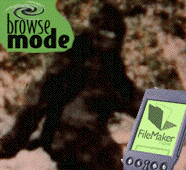![]()
June 2001
On the Trail of Sasquatch
by Brian Dunning
digg this article | del.icio.us this article
 Let
it never be said that FileMaker Pro doesn't have the mettle to
be a true trailblazer. For, lurking in the dark forests of the
Pacific Northwest, only one database has the courage to tread where
only Sasquatch has gone before.
Let
it never be said that FileMaker Pro doesn't have the mettle to
be a true trailblazer. For, lurking in the dark forests of the
Pacific Northwest, only one database has the courage to tread where
only Sasquatch has gone before.
Bill McClintock is the Executive Director of the Society for the Classification of Unknown Great Apes (SCUGA). By the size of his humble office, one might divine that he's also the Assistant Director, Executive Assistant, Head Underling and Under Secretary. Yet Bill's organization boasts over two thousand members, stored, naturally, in a FileMaker Pro database.
"A lot of people laugh at the Bigfoot stories," says Bill. "SCUGA is not interested in hoaxes, unsubstantiated reports, fake footprints, or anything else that makes Bigfoot research a laughing stock. We believe that if there is an unclassified species of great ape in the forests of the northwest, it should be properly characterized zoologically."
SCUGA does not work with any of the more popular aficionado groups such as Bigfoot Field Researchers Organization, www.bfro.net. Such groups maintain large databases of sightings. "Organizations like BFRO list anything and everything, no matter what joker reports it. So it's impossible to glean anything statistically useful out of their databases."
Bill's database is an impressively sophisticated system. If things dry up in Bigfoot research, he could have a fair career as a FileMaker consultant. He has a Members database with, sure enough, a shade over two thousand records. There's also a Sightings database, with many-to-many relationships reaching out to a whole score of Characteristics files. Like a true database pro, Bill refers to his files as tables, and to his fields as columns.
SCUGA's system uses a technique with as many names as Sasquatch itself, and which I'll call the viewer file. All of the interface resides in a single file with only a single dummy record. It contains tons of globals used as relational keys, and all the data is pulled in from the many associated files. "This eliminates all the navigation problems," says Bill, "and also makes it work faster over a network, since the viewer file is local on each user's machine." Quite the elaborate setup, especially when you consider the size of his office and staff.
Bill has played around a bit with Web Companion and hopes to deploy an online version of his database to let members perform research and input new data. "I'm a little worried about cranks putting in bogus data," says Bill. "So it's probably not going to be a publicly available web site with a domain." Bummer.
Exactly what kind of research would members do on this web site? "Looking for zoological trends among reports for comparative analysis," says Bill. "Useful sightings are reported by people with the expertise to recognize significant points of data and report them responsibly."
Significant points of data like what?
"Look at known species such as bears, foxes, or wolves. Their color and size varies with altitude and latitude: lighter fur the farther north you go, and larger mass to surface area ratio to conserve body temperature. Heat radiating structures, such as external ears, are also notably smaller toward the poles. A useful Bigfoot sighting would record all of these traits, plus a number of others."
And those traits stay on the record permanently, as Bill employs FileMaker Server 5 with its automated, unattended backup feature. The backups are written to an external Zip 250 drive. Bill rotates the cartridges every week, and once every four weeks, he stores one away as a permanent archive. A formidable assault on Bigfoot's effort to remain elusive.
I showed FileMaker Mobile to Bill on my Palm. He'd never seen it before, and was intrigued to say the least. "People in the field could use this to enter their data," he mused. "It's worth some more thought, for sure. It would need to sync up to my master database though." We brainstormed a little about giving a local single-user file to remote members, with a script that would synchronize the data to Bill's server. Ah, the things one could do if one only had the time.
At this rate, Gigantopithecus Americanus (North American Sasquatch) won't be a loner for much longer. As if the infra-red recorders, helicopters, and movement-triggered cameras aren't making his life hard enough, now all this database technology is making it a very close chase indeed.
